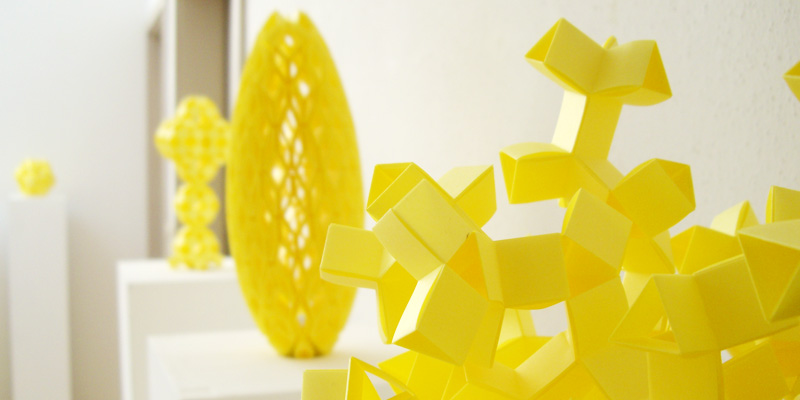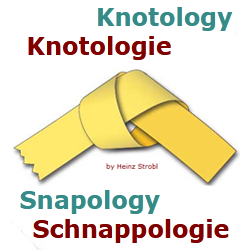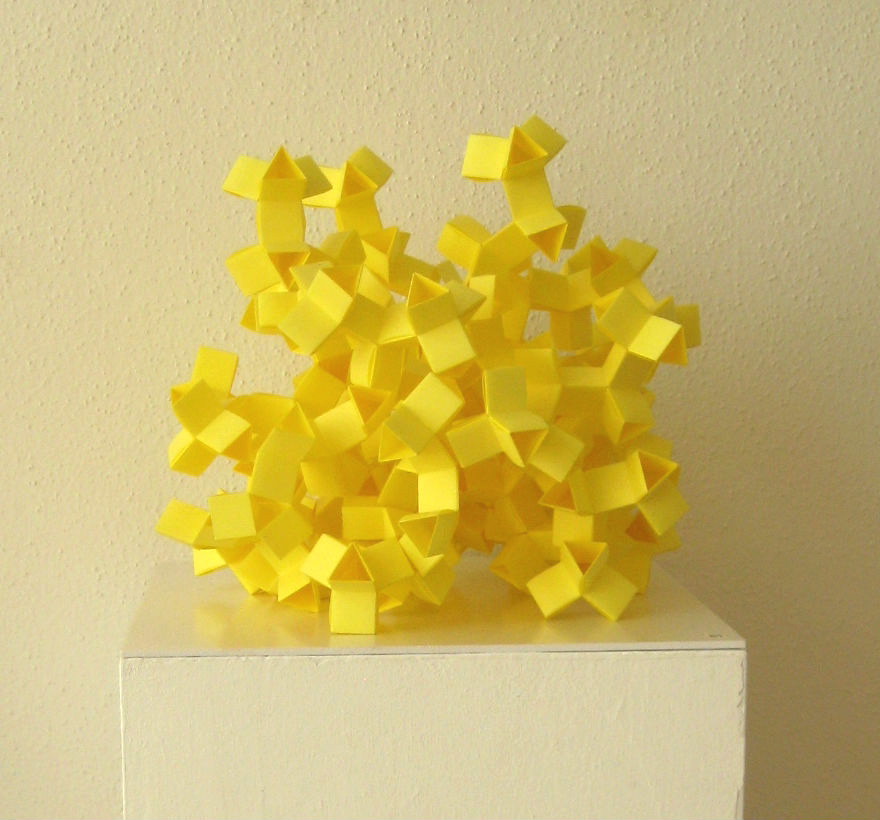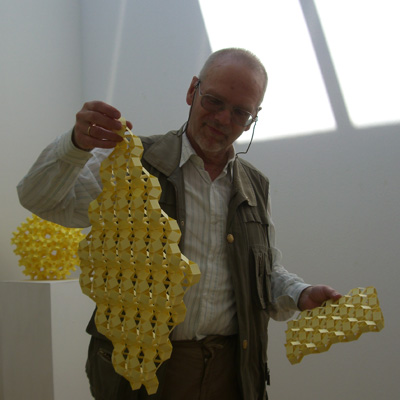Snapology by Heinz Strobl
Heinz Strobl creates geometric figures out of paper. The Aichacher invented his own folding techniques for this.
Geometry is Heinz Strobl’s passion. This also fits in with his training as a physicist and his work as an IT engineer. The way in which the 69-year-old from Aichacher lives out his passion is rather unusual: he folds paper. He even developed and researched his own folding techniques: knotology and snapology. Using these techniques, he folds geometric works of art. A job that requires mathematical precision. The forms of his artworks have a lot to do with mathematics, although they are not entirely geometric, as Strobl reveals.

Heinz Strobl called this work, which recreates the cosmic big bang, “Big Bang”. The showcases in which the Aichacher collects his works of art can be seen in the background.

Folding artist Heinz Strobl is fascinated by how the strictly restrictive repetition of triangles, for example, creates remarkable forms whose aesthetics result from the geometric order. These objects were created in snapology.

The models folded in knotology are very flexible. If Heinz Strobl didn’t topple it in the middle, it would simply collapse.

The models folded in knotology are very flexible. They resemble conical bodies or vases.
Until June 25, 2011, five origami artists show their individual handling of the material paper in gallery 13, Freising.






Heinz Strobl – structures, knotology, snapology
September 29th to November 9th
“Knotologie” and “Schnappologie” are the two folding techniques that characterize the work of the artist Heinz Strobl. Folded from strips of paper, his works are created on the basis of play, science and design in equal measure. Proportions, fantastic geometry and understanding of connections – what is shown here is an architecture of unlimited possibilities, which Heinz Strobl systematically sorts, classifies and makes accessible. One can approach his oeuvre in a philosophical as well as in a scientific way or in a very elementary way through the joy of artistic expression.

Raumfaltan, Barvaria 2015
Spatial folds
origami in the visual arts






I am fascinated by how remarkable forms emerge from the strictly restrictive repetition of, for example, squares. Their aesthetic results from simple or complex geometric order. But it is also accessible to the mathematically unbiased observer. (HS)
Heinz Strobl takes us a step further via the familiar path of recognizing three-dimensional objects in their two-dimensional images: He chooses the 120-cell, the four-dimensional analogue of the three-dimensional platonic dodecahedron and tries to realize its three-dimensional image in his snapology technique. Because the perspectival foreshortening can only be represented to a limited extent with the snap logic elements, which are always the same size, he can only realize parts of the 120-cell projection in his works. He dissects the 120-cell into different layers, each with a similar shortening, and then realizes each layer as a separate work.

Inspired by Snapology
 Harvard researchers designed a tunable, self actuated 3-D material that was inspired by Snapology. The designs could be used at multiple scales from nanoscale to meter scale. Some day it might be used to pack your house into a backpack or add a new window to a wall with the flick of a switch.
Harvard researchers designed a tunable, self actuated 3-D material that was inspired by Snapology. The designs could be used at multiple scales from nanoscale to meter scale. Some day it might be used to pack your house into a backpack or add a new window to a wall with the flick of a switch.
“Reconfigurable devices, whose shape can be drastically altered, are central to expandable shelters, deployable space structures, reversible encapsulation systems and medical tools and robots.
Knotology & Snapology, Germany

PROFILE
Heinz Strobl is known for his development of two types of modular origami using strips of paper. In Knotology, the strips are knotted into flat pentagons layered on one another, and woven and plaited to make models that, like his Snapology figures, are stable without the use of glue or tape. In Snapology, which he developed later, strips are folded into polygonal prisms (the units or modules) that are joined using a second set of strips that snap them together, creating geometric forms. He has exhibited his works internationally.
Main Research Source
- Knotology and snapology as an art form by Gerlinde Drexler, Aichacher Nachrichten(10/11/2015)

- Origami Galerie Freising - Heinz Strobl by Gerwin Sturm(10/06/2011)

- Träume aus Händen by Vielfaeltig2010 (13/06/2011)

- träume-aus-hände 2011 gallery 13, Freising(25/07/2011)

- Raumfalten (29/10/2015)

Some notes:
Models are made with paper “strips”, or, more precisely, from telex tape. Punched tape was used throughout the 19th and for much of the 20th centuries for programmable looms, teleprinter communication, for input to computers of the 1950s and 1960s, and later as a storage medium for minicomputers and CNC machine tools. This punched tape or perforated paper tape is a form of data storage that consists of a long strip of paper in which holes are punched.
The models are classified into classes and subclasses according to the kind of creases and/or the folding technique used:
- Closed cubes
- Open cubes
- Standard Snaology
- Locked Snapology
- Freestyle snapology
- Squares only
- Right angled Isoceles ‘Spheres’
- Various Right angled Isosceles
- Right angles Isosceles Octahedrons
- Twin tape permeating cubes
- Equilateral triangles
Source










